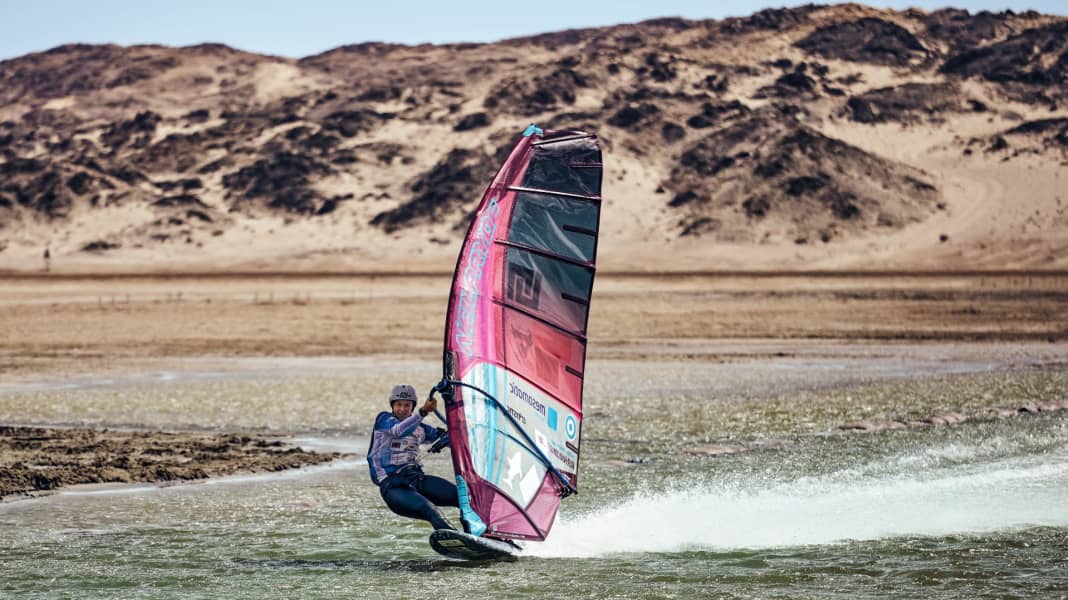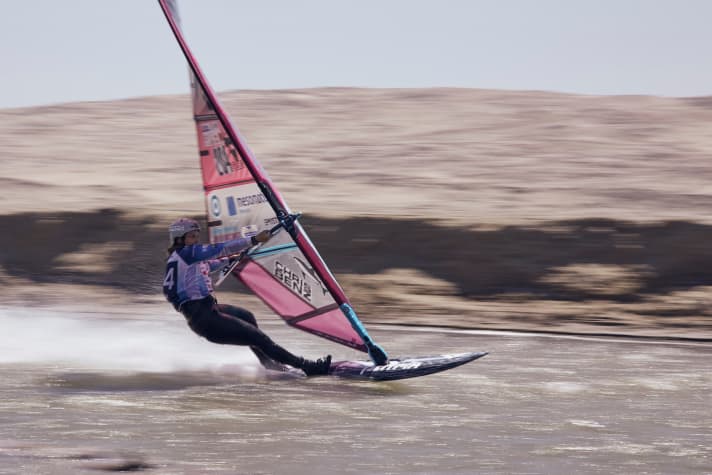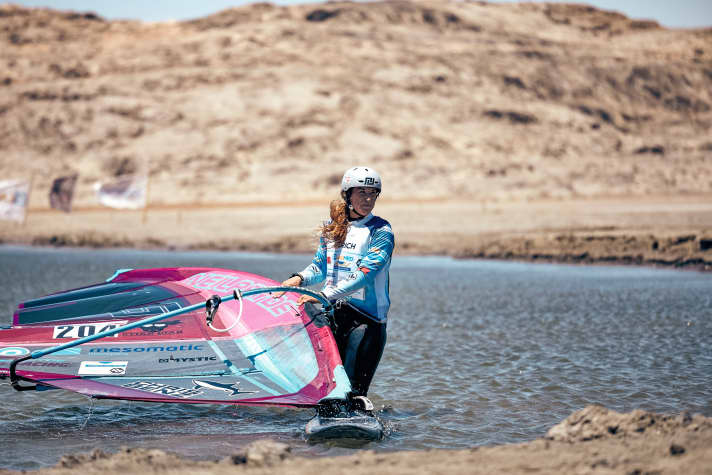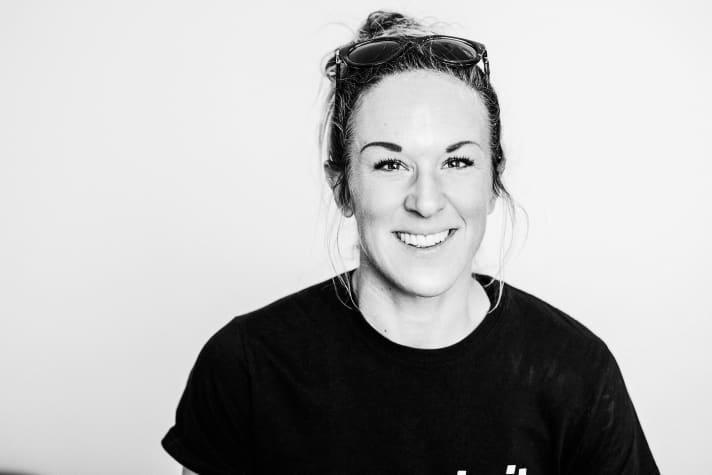
You're pretty much following in the footsteps of your compatriot Karin Jaggi. She held various world speed records for a long time. Is she your role model?
Karin and especially Patrik (Diethelm) were and are my windsurfing inspiration. But I don't want to compare myself with Karin, because in my eyes she is the most successful windsurfer of all time. I was travelling with Karin and Patrik for around seven years, as I was with Patrik's brother Remo. At that time, I played volleyball and beach volleyball and was always in places where there was no wind. So it soon became clear who was going to change sports. So I wanted to learn to surf and that's what I did. During this time, Karin became like a sister to me and of course I always looked up to her.
Many kids are introduced to windsurfing very early on by their parents. It was a bit different for you, wasn't it?
I didn't know anything about this sport for a long time - I didn't even realise it. Then, in 2012, I got on a board for the first time on Lake Garda in Malcesine. First I had to learn how to rig the board "only when you know how to prepare the equipment are you allowed on the water". No sooner said than done. I rigged up, they sent me on the water and then I spent the whole day running up the beach: sails in hand and running up on solid ground. And then back on the water. I had been given an ancient pink lifejacket and was then used as a buoy by the Diethelm family.
How did your passion for speed surfing come about?
After I started surfing in 2012, Patrik came back from Lüderitz/Namibia at the end of the year full of euphoria. His eyes sparkled when he told me about this speed channel and I knew: guys, I want to join you in 2013. Once more said done. I accompanied Patrik and Remo on their trip to Namibia. I couldn't stop marvelling and knew that I wanted to be able to do the same.
While the boys were out speeding, I learnt to loop surf in the bay. Because I hadn't been able to do that until then, as it was still my first year of windsurfing. Nevertheless, I completed my first defi. Without loops with a 125-litre board and a 4.0 sail. The guys said: "Easy, this is a race where you ride along the beach in flat water, you can easily do that..."
Yes, there were a few experiences like that, but after a year I was able to go out almost everywhere with the Diethelms and Karin. Even in Vargas on Gran Canaria. However, I couldn't do a water start yet - so Patrik removed the start sheet without my knowledge and yes, I had to learn the water start outside for better or worse.

What about the other disciplines - slalom, foil, wave, freestyle - do you do them too?
I take part in all the slalom regattas in Switzerland and I also like doing the defi. Freestyle is all too fast for me, I think I'm already too old for that. Wave on holiday is also fun for a change, as is foil. But my heart clearly beats for speed. Tighten up and off we go. I live right by the lake and it's an ideal slalom and foil lake. But dear Lake Uri can also be different when there's a Föhn storm with 30 to 50 knots. Then we also have decent waves. But instead of rigging up the wave material, I prefer to go to the other side of the lake and speed there. It's clean, but it's mega fun.
In real life, you have a very responsible and time-consuming job. What exactly do you do and how do you make time for windsurfing?
Until mid-March, I was HR manager at a large energy company. I looked after over 2000 people together with my team of four. But now I've moved within the Group and I'm still a HR Business Partner and no longer a manager. So I have less responsibility and I'm enjoying that to the full. As before, the deal now is that the work has to be done - that's clear - but I can invest the time in training without any problems. But then I have to get up at five in the morning or go back to the laptop in the evening after training. So my working/sports day can easily last twelve to 14 hours. But it's true for me.
For your goal of breaking three world records in 2019, you launched a crowdfunding campaign and raised 25,000 francs. How exactly did you do this and what should other surfers who are planning something like this bear in mind?
Crowdfunding with the company "I believe in you" came about by chance. The managing director was impressed by my passion and ambition and had the idea of why not make a project out of the "world record hunt". There weren't enough women tackling something like this. He then advised me and said that 25,000 was totally realistic. I was very sceptical about the whole thing but thought, why not give it a try? We drew up a concept, I looked for a sports sponsor - which I found in ski star Ramon Zenhäusern - and then we pushed it both in the media and digitally.
It was a lot of cold calling, which suits me, but I don't like doing it. But in the end, it raised the money, which was very helpful for me with all the travelling in 2019.

Before you went to Lüderitz, you had already broken the records for the nautical mile and the world hour record. Where did you set the times?
I put everything I had into speed in 2019. My entire training was focussed on speed and that's why I only took part in one slalom race. I spent as much time as possible in France in La Palme/La Franqui with my boyfriend, who is also my training partner, coach and favourite person. For us, it's the closest training spot for speed training. I surfed there most of the time on the Patrik Speed-board 37/39 and 33 (centimetre width) to get used to the boards and tested all sorts of things until I had set-ups that suited me. And that's how I set the records. At the "Prince of Speed" event, I set the world record for the nautical mile, which was broken after twelve years by Zara Davis. I achieved the world record for the hour on my first attempt at the neighbouring beach in Port La Nouvelle. I know that more is possible with both of them. That's why I'd like to attack them both again.
How does speed surfing on the channel differ from spots like La Franqui?
Good question. From my point of view, they are two completely different pairs of shoes: in La Franqui, as on the canal, the conditions are always different, but for the most part you sail downwind and then slingshotting into the waves. You can start wherever you want, but not with a jump start. There are many days when the water is "smooth as arse", but there are also many days when you have rolling chop. Furthermore, you always have to walk the course first and see where the sandbanks are. The half-wind course means you tend to ride in a slalom style. In addition, you have to turn up with a speedboard and an asymmetrical fin, which means, for example, in the nautical mile: 90 seconds of full throttle speed and 45 minutes of turning back.
In the canal I usually start in the loops - but now I have to learn the jump start! Depending on the angle, you have a short start phase with half wind and then slingshoots around the corner into the channel. Here, too, it can be anything from very flat - but then you usually have too much half wind - to very choppy. The position and the trim are completely different to La Franqui. The short start and the even shorter run-out are also always scary. And the tunnel vision - that doesn't exist in La Franqui either.
Do you think it's possible to achieve the same times on open water as in the canal?
No, I don't think so, unless we can find an open water spot where we can ride downwind without having to surf in the chop.
In the end, you were 0.39 knots short of breaking Zara Davis' record. Were you very disappointed and do you want to go for it again if you can?
Yes, I was actually very disappointed. Several times I was within 0.4/0.5 knots of the record, but it just wasn't enough. I got better and better at top speed until the last day with 48.2 knots, but over 500 metres it just wasn't possible. But I know it's possible. I could feel it.
I also know exactly what I need to work on to become even faster. However, not everything at the event in Lüderitz is in the hands of the riders alone.
Info about Heidi Ulrich

- Age: 35 years
- Place of residenceFlüelen/Switzerland
- ProfessionPersonnel managers
- Size/weight: 173 cm/70 kilos
- Surfing since: 2012
- Regatta debut: 2013
- Successes: 2 x speed world record nautical mile 37.26 knots; speed world record GPS over one hour 23.82 knots; fastest female open water windsurfer 40.4 knots over 500 metres and 44 knots max.; third fastest woman in the Lüderitz Speed Channel 46.1 knots over 500 metres (max. speed 48.2 knots)
- Favourite spots: At home
- HobbiesWindsurfing, biking, hiking, climbing, snowboarding, cross-country skiing
- SponsorsPatrik (boards), Duotone (sails), Mystic Switzerland, Heidi Liebt (caps), Stiär Biär (beer)

